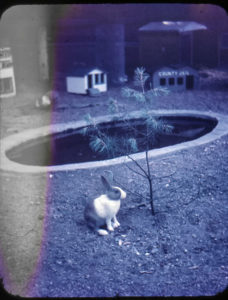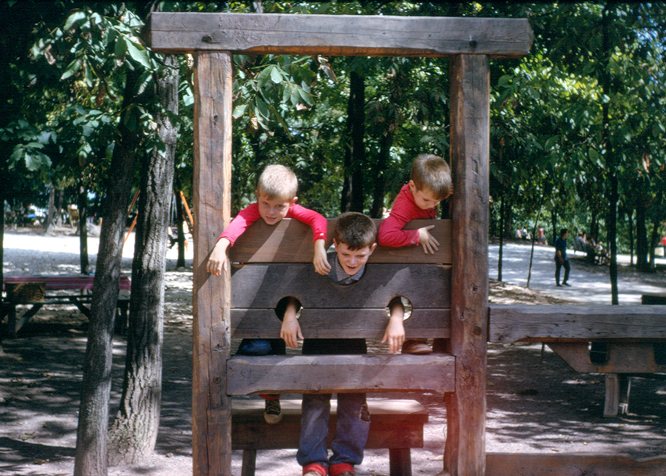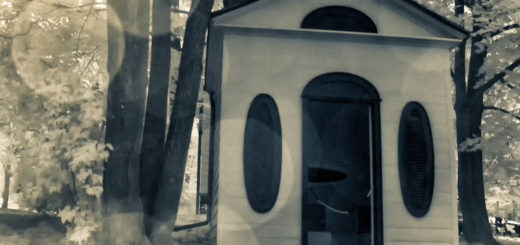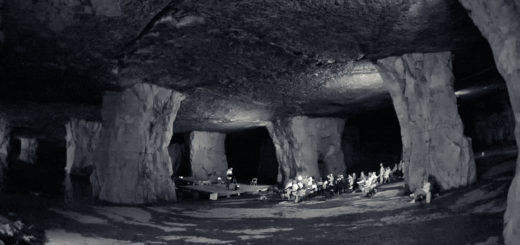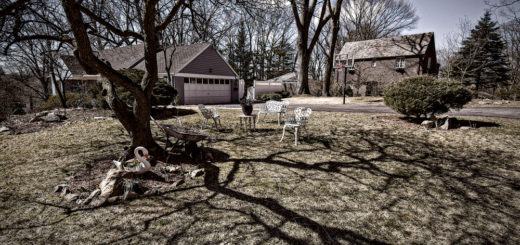Catskill Game Farm
According to the handwriting on its faded blue cardboard mount, the slide was “Taken at Game Farm in Catskills, July 1954.” An item acquired off eBay for a few dollars. It was included among a collection of a dozen other slides documenting an unknown family’s summer vacation. None of the pictures in this lot include any people. Presumably all of these shots were captured by the same photographer. This particular slide presents a curious scene. It is nearly achromatized by the passage of years. The image is blemished by a leak of light along its left edge. The subject, it would appear, is a large, undemonstrative bunny rabbit, sitting in profile on bare ground. Close by is a bedraggled pine sapling. Behind that, a small concrete pool hints of dark waters. In the background, nearly falling out of focus, another bunny can be made out, along with a couple of rabbit hutches. One of the hutches is made in the shape of a summer cottage, a miniature version of what was commonly seen across the vacation landscape of the Catskills in those times. The cottage/hutch is painted white and has little steps leading up to a little door. Very comfy looking. The other hutch, just to the right, is a darker, more elongated affair, almost disappearing into the shadows. This is no cottage. Painted across its grim facade, just below the gables, are the words “County Jail.” Barely discernable at the far back is the fence that establishes the bunny rabbit enclosure. The photographer must have been standing right in the middle of this lagomorph paddock when the shutter release was pressed. In most respects, this is an unremarkable and indeed flawed vacation snapshot. No wonder it turned up on eBay. But something else is going on here. The more time spent gazing into this orphan image, the more sketchy the world outside its frame becomes. Or so it seems. This is probably true of all photographs.
Catskill Game Farm was a popular animal theme park tucked away in a sylvan nook at the base of the mountains above the hamlet of Kiskatom. Roland Lindemann established the business 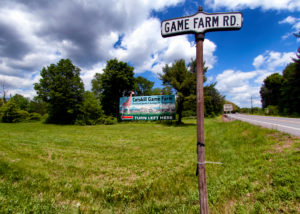 there in 1933. It began as a modest petting zoo, where visitors would stroll around the enclosed grounds, handing out Cracker Jack to a few tame deer, donkeys, and sheep. Over the next two decades, the Game Farm expanded to include exotic and not-so-tame animals, including lions, bears, rhinoceros, giraffes, and African porcupines. By 1958, the number of animals and diversity of species in residence on the property’s extensive acreage qualified the Game Farm to become a full-fledged zoo, at least in the eyes of the United States Department of Agriculture. It was the first private venture to receive this distinction. During its heyday in the 1960s, Catskill Game Farm was home to nearly 2,000 animals. Half a million visitors each summer passed through its iconic entryway, over which the sign proclaimed “Fun For The Whole Family.” And indeed it was, for several generations. By then the park employed eighty or so people, thirty of them year round. The business remained in the hands of the same family right up to October, 2006, when—after years of declining visitor numbers and increasing regulation—the gates of Catskill Game Farm were closed for good.
there in 1933. It began as a modest petting zoo, where visitors would stroll around the enclosed grounds, handing out Cracker Jack to a few tame deer, donkeys, and sheep. Over the next two decades, the Game Farm expanded to include exotic and not-so-tame animals, including lions, bears, rhinoceros, giraffes, and African porcupines. By 1958, the number of animals and diversity of species in residence on the property’s extensive acreage qualified the Game Farm to become a full-fledged zoo, at least in the eyes of the United States Department of Agriculture. It was the first private venture to receive this distinction. During its heyday in the 1960s, Catskill Game Farm was home to nearly 2,000 animals. Half a million visitors each summer passed through its iconic entryway, over which the sign proclaimed “Fun For The Whole Family.” And indeed it was, for several generations. By then the park employed eighty or so people, thirty of them year round. The business remained in the hands of the same family right up to October, 2006, when—after years of declining visitor numbers and increasing regulation—the gates of Catskill Game Farm were closed for good.
Generations of hearts were broken by the news. They were broken yet again just a couple of weeks later, when all of the park’s animals and equipment were put up for auction. By that point, the sobs of heartbreak were squelched by outcries over animal cruelty. One longtime resident of the park—a rhinoceros by the name of “Boom Boom”—drew particular attention from animal rights advocates. The fear was that Boom Boom—not to mention many of his fellow evictees from the menagerie—would wind up in the hands of animal exploiters, to be led off to the slaughterhouse or, worse, to a “canned hunt,” which is the trophy hunting equivalent of shooting fish in a barrel. As it proved, the winning bid—according to a 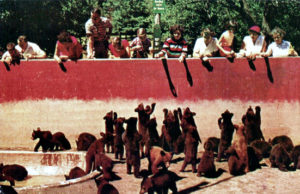 news report—came from a “laconic Texan” wearing a gray baseball cap. He paid $5,500 for Boom Boom, plus another $1,250 for his steel-barred shipping crate. When asked where he would be taking Boom Boom, the Texan replied with one dark word: “Home.” News of Boom Boom’s imminent homecoming spread quickly through the crowd of animal advocates in attendance. In short order, a wealthy clothing designer stepped up and offered to buy Boom Boom from the laconic Texan. The price for the rhino and his crate was jacked significantly, but in the end the two men struck a deal and Boom Boom was transported away to the hills outside of Sedona, Arizona, where he lived out the rest of his years on a spacious animal sanctuary, in more freedom and happiness than he had ever known before. As for the owners of the now-shuttered Catskill Game Farm, they had little patience for the animal rights advocates who had been hectoring them for months. One of the owners groused to a reporter: “You gotta understand, a lot of these people have nothing better to do—they’re the same people who eat Big Macs and wear leather shoes.”
news report—came from a “laconic Texan” wearing a gray baseball cap. He paid $5,500 for Boom Boom, plus another $1,250 for his steel-barred shipping crate. When asked where he would be taking Boom Boom, the Texan replied with one dark word: “Home.” News of Boom Boom’s imminent homecoming spread quickly through the crowd of animal advocates in attendance. In short order, a wealthy clothing designer stepped up and offered to buy Boom Boom from the laconic Texan. The price for the rhino and his crate was jacked significantly, but in the end the two men struck a deal and Boom Boom was transported away to the hills outside of Sedona, Arizona, where he lived out the rest of his years on a spacious animal sanctuary, in more freedom and happiness than he had ever known before. As for the owners of the now-shuttered Catskill Game Farm, they had little patience for the animal rights advocates who had been hectoring them for months. One of the owners groused to a reporter: “You gotta understand, a lot of these people have nothing better to do—they’re the same people who eat Big Macs and wear leather shoes.”
In the years following its closure, the buildings and grounds of the former game farm quickly fell into decay. Buildings collapsed, vegetation ran riot, fencing gave way. The few vehicles that found their way along the forgotten road leading to the erstwhile zoo would stop in the vacant parking lot so the occupants could gaze out upon the rubble and relics of days gone by.
Alas, Catskill Game Farm was gone, but far from forgotten. In recent years, the property has come under new ownership and a resurrection of sorts is taking place under the name of “The Old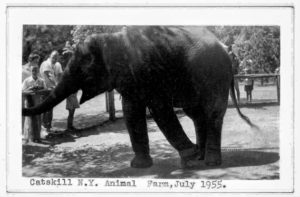 Game Farm.” Plans call for the development of a new kind of theme park, one in which visitors will walk through the ruins of the former theme park as they reminisce about their childhood. There won’t be any animals, but there will be plenty of memories. Already considerable progress has been made on renovations to the former giraffe house, which is being converted into a five-room inn. To be honest, the building does possess a certain allure. After all, it was the birthplace (in 2002) of last year’s internet sensation, April the Giraffe. She gave birth during a live video that was watched by more than a million people. At present, the archived YouTube video has been viewed more than 15 million times. In addition to the inn, the born again theme park will include campsites and an RV park. “Come camp at the abandoned zoo!” Already visitors are allowed to walk the property, as long as they register in advance. The hope is that someday a museum will be opened on the site, focusing on the history of the former zoo. Even with all these improvements, the primary draw of the Old Game Farm will always be nostalgia, the most secure theme park of them all.
Game Farm.” Plans call for the development of a new kind of theme park, one in which visitors will walk through the ruins of the former theme park as they reminisce about their childhood. There won’t be any animals, but there will be plenty of memories. Already considerable progress has been made on renovations to the former giraffe house, which is being converted into a five-room inn. To be honest, the building does possess a certain allure. After all, it was the birthplace (in 2002) of last year’s internet sensation, April the Giraffe. She gave birth during a live video that was watched by more than a million people. At present, the archived YouTube video has been viewed more than 15 million times. In addition to the inn, the born again theme park will include campsites and an RV park. “Come camp at the abandoned zoo!” Already visitors are allowed to walk the property, as long as they register in advance. The hope is that someday a museum will be opened on the site, focusing on the history of the former zoo. Even with all these improvements, the primary draw of the Old Game Farm will always be nostalgia, the most secure theme park of them all.
©John P. O’Grady
Originally appeared in The Mountain Eagle on September 28, 2018
